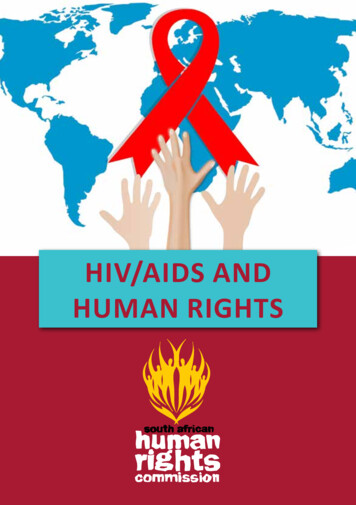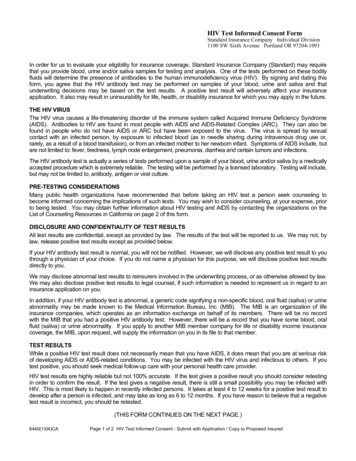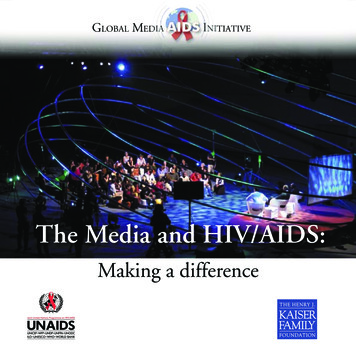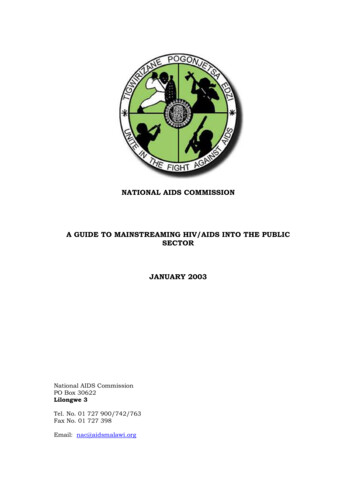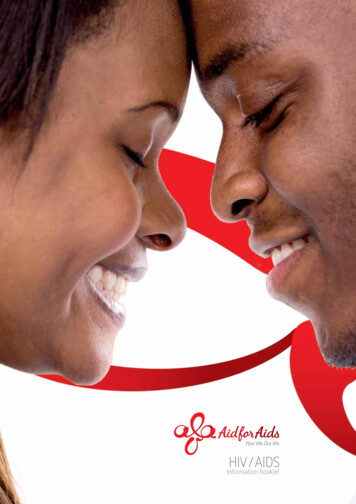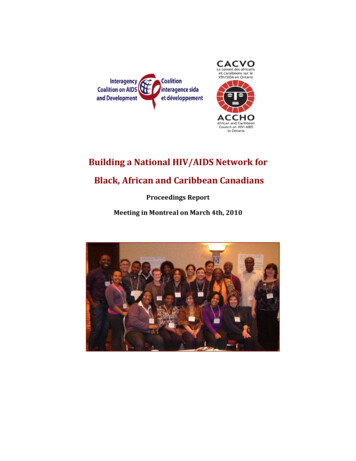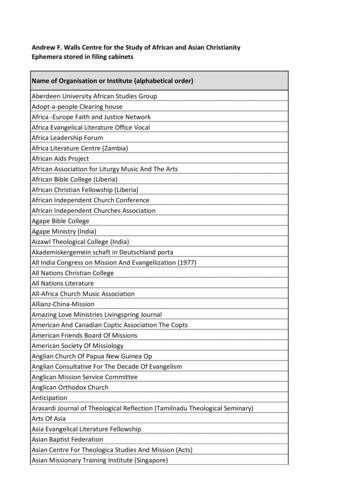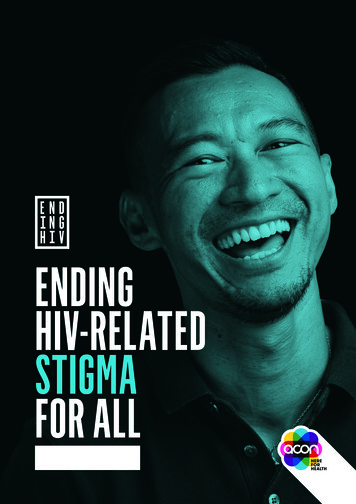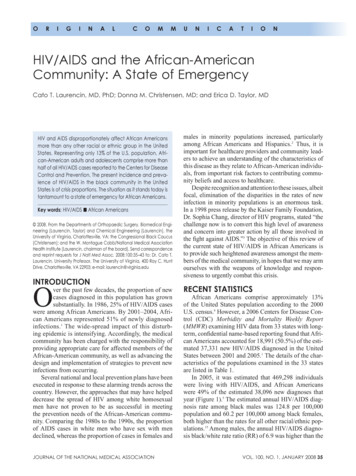
Transcription
originalcommunicationHIV/AIDS and the African-AmericanCommunity: A State of EmergencyCato T. Laurencin, MD, PhD; Donna M. Christensen, MD; and Erica D. Taylor, MDHIV and AIDS disproportionately affect African Americansmore than any other racial or ethnic group in the UnitedStates. Representing only 13% of the U.S. population, African-American adults and adolescents comprise more thanhalf of all HIV/AIDS cases reported to the Centers for DiseaseControl and Prevention. The present incidence and prevalence of HIV/AIDS in the black community in the UnitedStates is of crisis proportions. The situation as it stands today istantamount to a state of emergency for African Americans.Key words: HIV/AIDS n African Americans 2008. From the Departments of Orthopaedic Surgery, Biomedical Engineering (Laurencin, Taylor) and Chemical Engineering (Laurencin), theUniversity of Virginia, Charlottesville, VA; the Congressional Black Caucus(Christensen); and the W. Montague Cobb/National Medical AssociationHealth Institute (Laurencin, chairman of the board). Send correspondenceand reprint requests for J Natl Med Assoc. 2008;100:35–43 to: Dr. Cato T.Laurencin, University Professor, The University of Virginia, 400 Ray C. HuntDrive, Charlottesville, VA 22903; e-mail: laurencin@virginia.eduIntroductionOver the past few decades, the proportion of newcases diagnosed in this population has grownsubstantially. In 1986, 25% of HIV/AIDS caseswere among African Americans. By 2001–2004, African Americans represented 51% of newly diagnosedinfections.1 The wide-spread impact of this disturbing epidemic is intensifying. Accordingly, the medicalcommunity has been charged with the responsibility ofproviding appropriate care for affected members of theAfrican-American community, as well as advancing thedesign and implementation of strategies to prevent newinfections from occurring.Several national and local prevention plans have beenexecuted in response to these alarming trends across thecountry. However, the approaches that may have helpeddecrease the spread of HIV among white homosexualmen have not proven to be as successful in meetingthe prevention needs of the African-American community. Comparing the 1980s to the 1990s, the proportionof AIDS cases in white men who have sex with mendeclined, whereas the proportion of cases in females andJOURNAL OF THE NATIONAL MEDICAL ASSOCIATIONmales in minority populations increased, particularlyamong African Americans and Hispanics.2 Thus, it isimportant for healthcare providers and community leaders to achieve an understanding of the characteristics ofthis disease as they relate to African-American individuals, from important risk factors to contributing community beliefs and access to healthcare.Despite recognition and attention to these issues, albeitfocal, elimination of the disparities in the rates of newinfection in minority populations is an enormous task.In a 1998 press release by the Kaiser Family Foundation,Dr. Sophia Chang, director of HIV programs, stated “thechallenge now is to convert this high level of awarenessand concern into greater action by all those involved inthe fight against AIDS.”3 The objective of this review ofthe current state of HIV/AIDS in African Americans isto provide such heightened awareness amongst the members of the medical community, in hopes that we may armourselves with the weapons of knowledge and responsiveness to urgently combat this crisis.Recent StatisticsAfrican Americans comprise approximately 13%of the United States population according to the 2000U.S. census.4 However, a 2006 Centers for Disease Control (CDC) Morbidity and Mortality Weekly Report(MMWR) examining HIV data from 33 states with longterm, confidential name-based reporting found that African Americans accounted for 18,991 (50.5%) of the estimated 37,331 new HIV/AIDS diagnosed in the UnitedStates between 2001 and 2005.1 The details of the characteristics of the populations examined in the 33 statesare listed in Table 1.In 2005, it was estimated that 469,298 individualswere living with HIV/AIDS, and African Americanswere 49% of the estimated 38,096 new diagnoses thatyear (Figure 1).5 The estimated annual HIV/AIDS diagnosis rate among black males was 124.8 per 100,000population and 60.2 per 100,000 among black females,both higher than the rates for all other racial/ethnic populations.15 Among males, the annual HIV/AIDS diagnosis black/white rate ratio (RR) of 6.9 was higher than theVOL. 100, NO. 1, JANUARY 2008 35
HIV/AIDS and the African-American CommunityHispanic/white RR of 3.1. Among females, the black/white RR was 20.1 and the Hispanic/white RR was 5.3.African-American infants and children are alsoaffected by these disparities. In 2005, 91 (65%) of theestimated 141 infants perinatally infected with HIV wereblack.5 Of the 68 U.S. children (age 13) who receivednew AIDS diagnoses, 46 (68%) were black. In additionto disparities in infection rates, there are also differencesfound in the prognoses for infected children and adults.Of persons diagnosed with AIDS during 1997–2004, asmaller proportion of blacks (66%) were alive after nineyears compared with Hispanics (74%), whites (75%),and Asian and Pacific Islanders (81%) (Figure 2).6During the time period 2001–2004, HIV diagnosis rates among black males and females declined by4.4% and 6.8%, respectively.1 Results from a 2007 studyreported similar declines among African Americans inthe state of Florida.7 Although these declines in ratesof new HIV diagnoses appear promising, they may notdirectly reflect trends in HIV incidence due to influences from changes in testing behavior and surveillancepractices.15 Regardless of the trends (Figure 3), AfricanAmericans remain disproportionately affected by highrates of HIV/AIDS. As the number of cases continues torise6 and the longevity of infected individuals increasesdue to advances in antiretroviral therapies, the factorscontributing to these higher rates will need to be critically examined and taken into consideration.Risk Factors InfluencingTransmissionThere is no simple answer to the cause of the disparities seen in African Americans in regards to HIV/AIDS.In the past, explanations for the disproportionate epidemicfocused on individual risk behaviors and race differencesin activities related to sex or drug use. However, it has beenrecently recognized that African Americans report lessrisky sexual activity and drug use than their white counterparts.8 For example, though African-American youth doreport more sexual behavior earlier than white youth,9 consistent use of a reliable means of contraception has a stronger association with African-American youth and adultsthan the white population.10-12 Furthermore, white adolescents are more likely to use certain illicit drugs than African Americans, initiating drug use at younger ages.13 Inaddition, a study examining the risk behaviors of femalejail prisoners reported that rates of needle-sharing weresignificantly higher among white females than amongeither African-American or Latino women.14Nevertheless, according to updated 2001–2005MMWR CDC data arranged by transmission category,among HIV infected men and women with risk factorsof intravenous (IV) drug use and high-risk heterosexual contact, more than half in each category were African American (men: 53.8% and 65.7%; women 58.8%and 69.5%, respectively).15 Thus, African Americansare again overrepresented in these essential categories of transmission. Most individuals with HIV/AIDSin the category of men who have sex with men (MSM)Table 1. Estimated number and percentage of new cases of HIV/AIDS by race/ethnicity and selectedcharacteristics—33 states, 2001–2005From the CDC Morbidity and Mortality Weekly Report 200736 JOURNAL OF THE NATIONAL MEDICAL ASSOCIATIONVOL. 100, NO. 1, JANUARY 2008
HIV/AIDS and the African-American Communitywere white (42.8%), with smaller percentages of black(36.1%) and Hispanic (19.0%) individuals.Within the African-American population alone, mostHIV/AIDS diagnoses of black male adults and adolescents at the end of 2005 were classified as MSM (48%),followed by intravenous drug use (23%), high-risk heterosexual contact (22%) and MSM in combination withintravenous drug use (7%).5 Among black female adultsand adolescents, most HIV/AIDS diagnoses were classified as high-risk sexual contact (74%), followed by IVdrug use (24%). These reported statistics are displayedgraphically in Figure 4. The risk factors influencingtransmission among the African-American communityare reviewed here individually.Sexual Risk FactorsAmong female adults and adolescents, from 2001–2005, the estimated number of AIDS cases decreasedamong IV drug users and increased among both femalesand males exposed through high-risk heterosexual contact.6 The data show that black women are most likelyto be infected with HIV as a result of sex with men whoare infected with HIV.15 Studies have postulated lack ofknowledge about their male partners’ possible risk factors for HIV infection, including unprotected sex withmultiple partners, IV drug use or bisexuality as drivinginfluences for this predominant mode of transmission.16Furthermore, black women are more likely than whitewomen to have acquired HIV heterosexually.17 Becauseof the disproportionate and increasing number of heterosexually acquired cases, it has been suggested thatminority communities at risk for HIV infection be considered a high priority for prevention and education programs specifically targeting heterosexually active adolescents and adults. If the risk for African-Americanfemales continues to go unrecognized, the consequenceswill undoubtedly be further increases in heterosexualtransmission rates.Sexual contact is also the main risk factor for blackmen, with male-to-male sexual contact being the predominant mode of transmission.5 High-risk heterosexual contact is less common as a primary risk factor forHIV/AIDS cases among black male adults and adolescents, though the rate is increasing. In the current available literature, supported hypotheses to explain the disproportionate higher incidence of HIV/AIDS in blackMSM males compared to other racial groups includeda higher incidence of past or current STD diagnoses aswell as lack of HIV status awareness and testing earlyin the progression of their disease among black MSMmales compared to other groups of MSM.18 From 2004–2005, the National HIV Behavioral Surveillance System(NHBS) surveyed 1,767 MSM males who frequentedMSM-identified venues, such as bars, street locations,dance clubs, cafés, retail stores, gay pride events, socialorganizations, gyms, sex clubs and parks, in five U.S.JOURNAL OF THE NATIONAL MEDICAL ASSOCIATIONcities. Of the black MSM males included in the study(25% of study population), 46% were HIV positive.Of those HIV positive, 67% were previously unawareof their HIV status.19 These data underscore the significance of testing and improving primary prevention practices for MSM males in the black population.Sexually Transmitted DiseasesThe highest rates of sexually transmitted diseases(STDs) are found among the black population. In 2005,African Americans were 18 times as likely as whites to havegonorrhea (representing approximately 68% of the totalnumber of cases in 2005) and approximately five times aslikely to have syphilis (comprising 41% of all primary andsecondary cases in 2005).20 Inflammatory STDs, such asgonorrhea, have been associated with increased HIV susceptibility and infectiousness, and may act by increasingthe number of white blood cells in the genital tract or byelaborating cytokines that upregulate HIV expression andincrease the viral load in the genital tract. Ulcerative STDs,such as syphilis, afford additional portals of entry throughmucosal ulcerations and also recruit inflammatory cellsthat bind and propagate HIV infection.21In short, the presence of certain STDs can increaseone’s chances of contracting HIV infection 3–5-fold,and an individual infected with both HIV and certainSTDs has a greater chance of spreading HIV to others.22Accordingly, the high rates of HIV infection for the African-American community may be partly attributable toa high prevalence of STDs that facilitate HIV transmission,18 and barriers to acquiring sexually transmitted diseases should be an essential component of HIV/AIDSprevention strategies within this population.Figure 1. Race/ethnicity of persons (includingchildren) with HIV/AIDS diagnosed during 2005Adapted from CDC Fact Sheet: HIV/AIDS Among AfricanAmericans5VOL. 100, NO. 1, JANUARY 2008 37
HIV/AIDS and the African-American CommunitySubstance UseIllicit drug use is an important primary risk factorfor HIV/AIDS infection among African Americans,noted to be the second leading cause of HIV infection for both black men and black women.6 Aside fromthe direct infectious risks of needle-sharing, there arealso indirect mechanisms that lead to an increase HIVinfection and inferior disease progression in this population. Substance users are more likely to engage inhigh-risk behaviors, such as unprotected sex, when theyare under the influence of drugs and alcohol.5 Furthermore, drug use has an impact on treatment success. Astudy of female cocaine users, predominantly AfricanAmerican women, showed that substance users wereless likely than nonusers to take their antiretroviral therapies exactly as prescribed.23 The authors concluded thatHIV-infected black women substance users may requiresustained treatment and counseling to help them reducesubstance use and adhere to antiretroviral therapy.IncarcerationThe number of individuals in U.S. prisons and jailshas increased significantly over the past decade, withnearly 1.4 million people incarcerated in U.S. federal orstate prisons in 2003.24 This growth is even more evidentamong the black community. Between 1984–1997, therate of current incarceration among African-Americanmen went from one in 30 individuals to one in 15.25 By2003, blacks were five times more likely than whites tohave been to jail, 39% of local jail inmates were black,24and 44% of the prisoners under federal or state jurisdiction were African Americans.26 From another data perspective, as of 1997, an African-American male was estimated to have a one in four likelihood of going to prisonin his lifetime, compared with a chance of one in 23 for awhite male.27 Without question, these racial disparities aredevastating to the social networks, family relationshipsand economic stability within the black community.There is widespread concern about the effects of incarceration on HIV/AIDS risk in African Americans. Theprison environment is indeed a high-risk setting for thetransmission of HIV/AIDS as a result of the prevalence ofHIV among inmate populations and the high-risk activities that may occur within the institutions, including unprotected risky sexual contact, drug use and the potential risksfrom nonsterile tattooing.28 Shockingly, one-fourth of allpeople living with HIV in the United States in 1997 wereincarcerated at some point during the year.29In addition to any risks associated with the prisonenvironment, investigators have considered the longterm consequences of incarceration for the lives ofreleased inmates.8 In terms of social network and relationship disruption, Hoffman and colleagues foundthat individuals in networks with higher rates of turnover (more new members entering the network andmore members leaving) were more likely than others toengage in HIV risk behaviors.30 The economic securityof released inmates is also affected by their criminal his-Figure 2. Proportion of persons surviving, by months after AIDS diagnosis during 1997–2004 and by race/ethnicityAdapted from CDC HIV/AIDS Surveillance Report, 2005638 JOURNAL OF THE NATIONAL MEDICAL ASSOCIATIONVOL. 100, NO. 1, JANUARY 2008
HIV/AIDS and the African-American Communitytory in several ways, including the reluctance of employers to hire individuals with criminal records. Economicinstability may lead individuals to engage in “survivalsex,”31,32 and risky drug use,33 both serious risk factorsfor HIV/AIDS. Furthermore, former inmates’ access todrug treatment services is generally limited by their lackof financial resources.8By and large, the degree to which African Americansare disproportionately more likely to be incarcerated relative to white individuals contributes to the racial disparities in HIV/AIDS. Current recommendations to furtherdelineate the role of incarceration include large-scalemeta-analyses to estimate the proportion of black maleinfections attributable to transmission to incarceration.Socioeconomic Status andAccess to HealthcareFinally, studies have found multifactorial associations between higher incidence of HIV/AIDS andlower income.34 Limited access to high-quality healthcare, housing and HIV/AIDS prevention and educationprograms both directly and indirectly increase the riskfactors for HIV infection. In 1999, nearly one in fourAfrican Americans was living in poverty.35 The overrepresentation of HIV within this community has beenlinked to the consequences of marginalized social status and poverty, including higher risks for homelessness,drug use, incarceration and risky sexual behavior, all ofwhich contribute to infection with and transmission ofHIV/AIDS within the community as mentioned in previous sections of this review. In addition, data from theHIV Cost and Services Utilization Study (HCSUS), theonly nationally representative study of people with HIV/AIDS receiving regular medical care, showed that accessto healthcare is heavily influenced by race and ethnicity:blacks were more likely to report postponing medicalcare because they lacked transportation, were too sickto go to the physician or had other competing needs.36More often than not, African Americans and individuals living in poverty do not have adequate access to thehealth education, prevention plans and treatments available to those who are not impoverished.37Along these lines, access to care can be improved byaccess to health insurance (public or private). Expectedly, insurance coverage of those with HIV/AIDS varies by race and ethnicity. According to HCSUS, African Americans with HIV/AIDS were more likely to bepublicly insured or uninsured than their white counterparts.38 More than half of African Americans in the study(59%) relied on Medicaid compared to 32% of whites.Figure 4. Transmission categories for AfricanAmerican adults and adolescents living withHIV/AIDS at the end of 2005Figure 3. Cases of HIV/AIDS among personsaged 13, by year of diagnosis and race/ethnicity, 2001–2005Adapted from CDC HIV/AIDS Surveillance Report, 20056JOURNAL OF THE NATIONAL MEDICAL ASSOCIATIONAdapted from CDC Fact Sheet: HIV/AIDS Among AfricanAmericans5VOL. 100, NO. 1, JANUARY 2008 39
HIV/AIDS and the African-American CommunityOne fifth of the black participants (22%) were uninsuredcompared to 17% of whites. Thus, socioeconomic statusrepresents another likely contributing factor to the racialdisparities of HIV/AIDS in African-Americans.HIV Serostatus AwarenessThe high level of unrecognized HIV infectionsamong African Americans is a public health concern.Individuals unknowingly infected with HIV cannot benefit from earlier lifesaving therapies, nor can they protect their partners from becoming infected with HIV.5 Alarge 2004 Kaiser Family Foundation survey found that,although African Americans are more likely than whitesto say they have been tested for HIV, particularly in thelast year, almost one-third of the African Americans surveyed have reported having never been tested for HIV(Figure 5).39 The lack of screening is even more concerning among black MSM. Of black MSM individualswho tested HIV positive in a 2005 National HIV Behavioral Surveillance study, more than two-thirds were previously unaware of their HIV status.19 Timely diagnosisis also critical. CDC surveillance data shows that, of allHIV infections diagnosed in African Americans in 2004,40% were diagnosed with AIDS 12 months later.6Community Beliefs andPerceptionsHIV/AIDS ranks first as the most urgent health problem facing the nation named by African Americans.39Compared to white individuals, African Americans aremore likely to be personally concerned about the disease, in terms of themselves and their children, and arealso more likely to know someone who has HIV/AIDSor has died from AIDS. African Americans are also morelikely to say there is a significant amount of discrimination against people with HIV/AIDS in the United Statestoday. Despite these statistics, the HIV/AIDS epidemichas created: 1) significant stigma within the AfricanAmerican community and also 2) outward mistrust ofthe biomedical community, both hampering the population’s ability to fully engage in HIV/AIDS prevention.In a community where religious leaders are criticallyimportant, black churches play a major role in shapingcultural norms and attitudes in relation to beliefs aboutsexuality. Openly discussing topics such as sexuality,homosexuality, sex outside marriage, drug use and otherprivate issues has always been taboo. Raising awarenessabout HIV/AIDS thus becomes a huge challenge and,in some cases, can lead to denial about HIV, decreasing testing among the population. Early in the courseof epidemic, community-based organizations, particularly those serving drug users, were likely to acknowledge the AIDS epidemic, whereas religious leadersmaintained a distance.40 This unequal movement withthe community has been postulated to be a source ofgreat concern given the importance placed on religiousinstitutions. National surveys report that the majority ofAfrican Americans are members of a church, and thesesectors have great influence on community attitudes,even for nonmembers. For a variety of reasons beyondthe scope of this review, teachings have led to prejudicewithin many black communities towards homosexuality. The end result, in many instances, is justified discrimination and marginalization by heterosexuals. Thisdecreases the amount of open discussion and educationabout HIV/AIDS and, as a result, there is a lack of wide-Figure 5. Percent of surveyed individuals who report being tested by race/ethnicityFrom Kaiser Family Foundation Survey of Americans on HIV/AIDS3940 JOURNAL OF THE NATIONAL MEDICAL ASSOCIATIONVOL. 100, NO. 1, JANUARY 2008
HIV/AIDS and the African-American Communityspread community support.Mistrust of the biomedical community by AfricanAmericans has been documented over centuries, rooted inhistorical racial discrimination in the nation’s healthcaresystem, including the well-known Tuskegee Syphilis studytravesty.41 Such mistrust has also been linked to conspiracybeliefs about HIV. In 1999, black research assistants conducted a door-to-door survey of 500 black adults in SanBernadino, CA.42 Nearly 27% of those surveyed endorsedthe view that HIV is an artificially created virus designedby the federal government to exterminate the black population. Furthermore, those who agreed that AIDS is a conspiracy against them tended to be culturally traditional,college-educated men who had experienced considerableracial discrimination. A second large survey of AfricanAmericans reported that, among men, stronger conspiracybeliefs were significantly associated with more negativecondom attitudes and inconsistent condom use.43Given the highly imbalanced prevalence rates of HIV/AIDS within the African-American community, identifying any barriers to prevention efforts is essential forthe design and implementation of effective interventionsin black communities. Lack of open HIV/AIDS discussion and pervasive conspiracy beliefs must be addressedin the context of prevention strategies.Masking Homosexual BehaviorHomophobia and stigma can cause some black MSMmales to identify themselves as heterosexual or to notdisclose their sexual orientation. In a 1998 psychologystudy from the University of Illinois, qualitative datafrom individual interviews with 18–29-year-old African-American MSM males were used to examine therelationship of negative attitudes toward homosexuality, self-esteem and risk for HIV.44 Respondents perceived members of their communities as holding negative attitudes toward homosexuality, and many thoughtthe African-American community was less acceptingof homosexuality than the white community, leading tosignificant psychological stresses. In addition, respondents articulated several mechanisms by which low selfesteem and distress might be associated with sexualbehaviors that put one at risk for HIV.Termed by the media first in 2001 as the “down-low”phenomenon, it was widely debated that being openlyhomosexual may lead to considerable stigma in communities, such as the African-American community, wheretraditional family behavior is greatly valued. This leadsto engagement in male-to-male sexual contact in secretwhile publicly maintaining heterosexual relationshipswith women. Some critics later argued that this negativemainstream attention wrongfully linked the down-lowphenomenon to solely African-American men, clouding the real contributors to the growing HIV/AIDS epidemic among this population. For example, one authorargued that the down-low debate demonized black men,JOURNAL OF THE NATIONAL MEDICAL ASSOCIATIONstigmatized black women and encouraged an unhealthy“battle of the sexes,” distracting attention from the issueof HIV prevention, personal responsibility and condomuse.45 There is also evidence that black MSM males whodo not disclose their homosexual or bisexual activitiesengage in a lower prevalence of HIV risks than blackMSM males who do disclose. Furthermore, black menwho are currently bisexually active account for a verysmall proportion of the overall population of black men(estimates of approximately 2%).46Still, in a CDC-sponsored study of 8,780 MSM withHIV infection or AIDS, 24% of non-Hispanic blackMSM identified themselves as heterosexual, comparedwith 6% of non-Hispanic white MSM.47 It was then suggested that minority community leaders should promotedialogue about issues of sexual orientation to overcomesocial barriers to HIV prevention for African-AmericanMSM, especially among young men.Strategies for Preventionand ActionDisproportionately high rates of infection amongblacks highlight the need to expand HIV-preventioninterventions known to be effective and implement new,improved and culturally appropriate HIV/AIDS strategies. Since the early beginnings of the epidemic, the CDChas funded programs that: 1) help individuals learn theirHIV status, 2) help high-risk HIV-negative persons avoidinfection, 3) support prevention services for persons living with HIV infection, and 4) help track the course of theepidemic and identify new and enhanced interventions.48However, given the disparities for blacks more than anyother race or ethnicity, the CDC recently committed toreassessing, strengthening and expanding its efforts toaddress the epidemic among African Americans.Action strategies to accomplish this culturally specific outreach include expanding access to resources bybuilding linkages with other organizations that providerelated social and health services to African Americans(e.g., employment, housing and mental health services)to make HIV prevention information and services morewidely available. Attempts are also being made to promote early HIV testing as a normal part of healthcarescreenings for all African Americans to increase opportunity for HIV diagnosis and early treatment. Furthermore,African-American researchers, including behavioral scientists, anthropologists, psychologists and sociologists,are being recruited to develop HIV prevention interventions tailored to the needs of the black community. Perhaps even more challenging will be the objective taskto mobilize broader community action, fostering forumssuch that African Americans can talk about HIV/AIDSin places where they live, work and worship. One strategy to create such vast change involves merging HIV/AIDS prevention with efforts against racism, homophobia, joblessness, sexual violence, homelessness, subVOL. 100, NO. 1, JANUARY 2008 41
HIV/AIDS and the African-American Communitystance use, mental illness and poverty.There are additional initiatives recently put in place thatare specific to high-risk subgroups of African Americans,including programs for incarcerated men upon release andprevention strategies for homosexual and bisexual blackmen. In addition to national organizations and programs,such as National Black HIV/AIDS Awareness Day, thereare several opportunities for members of the biomedicaland African-American communities to collaborate andsupport these efforts, decreasing the deep-rooted racialhealth disparities in HIV/AIDS that currently exist.tages and pitfalls of current HIV prevention strategies forAfrican Americans, with data then being used to steer public policies in a positive direction. Psychologists and sociologists stand to reach the males and females strugglingwith consequences of having to re-establish their socialnetworks after release from incarceration or followingcondemnation for their sexuality. Regardless of the modeof contribution, the call for action has been presented. TheHIV/AIDS crisis in African Americans as it stands todayrepresents a state of emergency.Conclusions1. Centers for Disease Control and Prevention. Racial/ethnic disparities indiagnoses of HIV/AIDS-33 states, 2001–2005. MMWR Morb Mortal Wkly Rep.2007;56(09):189-193. www.cdc.gov. Accessed 08/15/07.2. Centers for Disease Control and Prevention and Health Resources andService Administration. Healthy People 2010: Understanding and ImprovingHealth—HIV, 2000;2:13-14. www.healthypeople.gov. Accessed 08/15/07.3. Kaiser Family Foundation. African American and HIV/AIDS survey, 1998.www.kff.org/hivaids/1372-afr amerpr.cfm. Accessed 08/15/07.4. US Census Bureau. Population estimates: entire data set.
men, with male-to-male sexual contact being the pre-dominant mode of transmission.5 High-risk heterosex-ual contact is less common as a primary risk factor for HIV/AIDS cases among black male adults and adoles-cents, though the rate is increasing. In the current avail-able literature, supported hypotheses to explain the dis-



